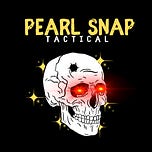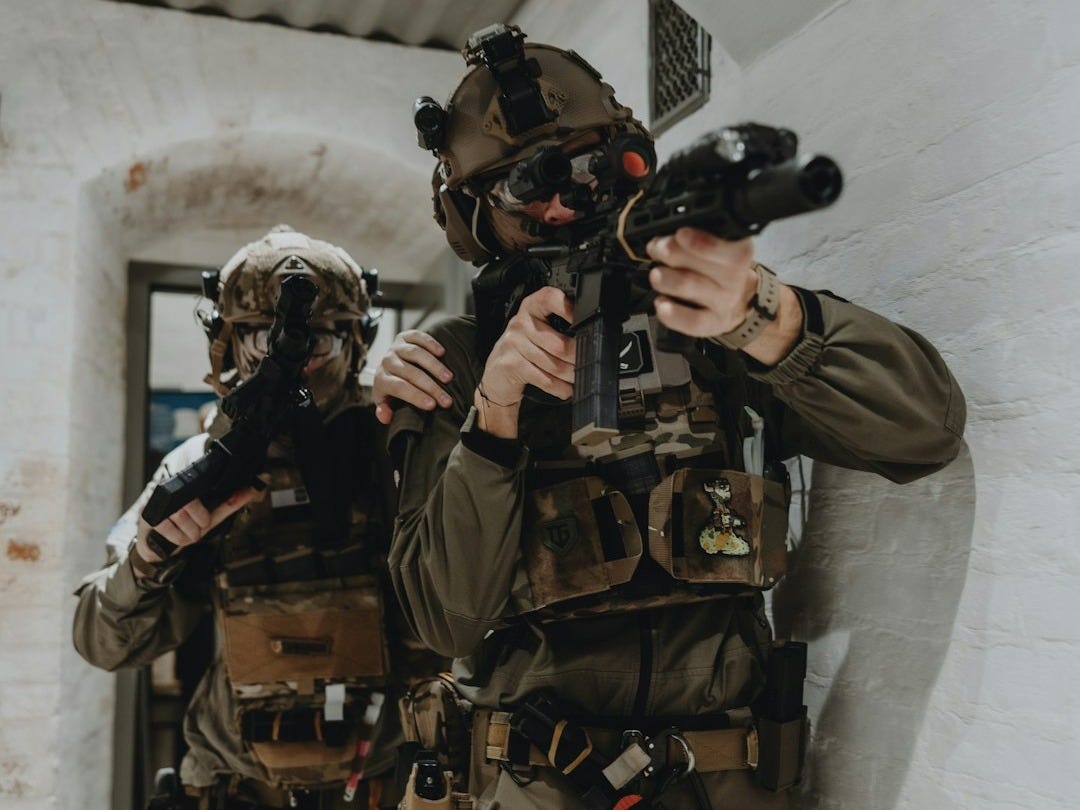Today we’re diving into one of the more heated debates in the firearms and training community — Should civilians be training in CQB? Close Quarters Battle. Is it a useful skill, a fantasy-driven distraction, or something in between? If you’ve spent time in the training world, you’ve probably heard both extremes: "Civilians have no business learning room clearing" — or — "CQB is essential to defending your home and loved ones." So which is it?
I’ll lay out both sides of the argument, share my own view, and maybe challenge a few assumptions along the way. Whether you’re military, law enforcement, or a civilian shooter, there’s something in here for you.
So, let’s go…
Part I: What is CQB, really?
Before we start debating its value, let’s define what CQB actually is. Alex and I did a whole episode about this in the past entitled, CQB Essentials. In that episode, we did a deep dive on the principles of CQB, we busted some myths and misconceptions, discussed best practices, and noobie mistakes to avoid, and much more. You can check it out here.
Without rehashing all the information covered in that episode, I’ll just say that Close Quarters Battle can refer to high-risk operations conducted in close or confined spaces — buildings, hallways, stairwells — where speed, surprise, and violence of action are key. It's typically team-based, with a heavy focus on angles, sectors of fire, communication, and rapid threat identification. It’s more nuanced than that, but for the purposes of this transmission, that’s what we’re talking about.
CQB is not just "fighting indoors." It's a methodical, high-stakes discipline born from military and law enforcement missions: hostage rescue, counter-terrorism, drug raids, high-value target capture.
That distinction matters. Because when we talk about civilians training in CQB, we need to ask: Are they trying to replicate the mission? Or are they borrowing methods to improve other skills?
Part II: The Critics' Perspective
Let’s take a look at the critiques. Many professional voices in the training community argue that civilians have no business learning CQB. And their reasons aren’t without merit.
Argument One: Lack of Contextual Need. Civilians aren’t breaching doors to serve warrants or clear terrorist hideouts. Their job isn’t to go into the fight — it’s to avoid it when possible. So the tactics designed for direct action missions may be misapplied.
Argument Two: High Skill, High Risk. CQB is unforgiving. One bad angle, one lapse in trigger discipline, and someone gets hurt or killed. Even professionals train constantly and still make mistakes. Civilians, in most cases, lack the time and repetition to build safe, effective CQB habits.
Argument Three: No Support Structure. No comms, no backup, no medevac. If you're clearing a hallway solo and it goes sideways, there's no team coming in behind you. The risks escalate quickly without the structure of an organized force.
Argument Four: Fantasy-Driven Training. There’s a concern — and it’s real — that some civilians are chasing CQB for the wrong reasons. They’re not training to be protectors. They’re LARPing. They’ve watched too many tactical Instagram reels and want to be Delta Force for a day. That mindset can breed recklessness.
These are fair critiques. And we should take them seriously. But they’re not the whole story.
Part III: The Case For Civilians Learning CQB

Now here’s where I offer some pushback. Because I do teach CQB to civilians — under the right conditions. And here’s why.
Point One: CQB Demands Mastery of Fundamentals. CQB is a forcing function. It demands tight muzzle control, fast and accurate shooting, solid movement, communication, and decision-making. It exposes gaps in your fundamentals and forces you to fix them. In that way, it’s one of the most honest training environments you can step into.
It’s a truth-teller. If your trigger discipline is sloppy, if your movement is erratic, if your situational awareness is poor — CQB will let you know. Fast. That’s why it’s valuable: it puts pressure on your core skills and gives you immediate feedback. Weaknesses can’t hide in the shoot house.
Point Two: Home Defense Application. Civilians don’t need to clear buildings — until they do. If you have kids in bedrooms down the hall, you may need to move to them. You may need to clear a hallway or a room, solo, under stress. Understanding CQB concepts — like threshold evaluation, angle management, and limited penetration — gives you an edge in protecting your family.
Point Three: Decision-Making Under Stress. CQB scenarios, especially force-on-force, train rapid threat identification, target discrimination, and judgment. That’s not fantasy. That’s the kind of stress inoculation that prepares you to make life-or-death decisions under pressure.
Point Four: Discipline and Humility. Good CQB training humbles people. It teaches that you’re not invincible. That you’re vulnerable. It reinforces the idea that avoiding a fight is always preferable. The right training doesn’t inflate egos — it tempers them.
Point Five: Access to Quality Has Improved. We’re no longer in the era where CQB training was locked behind the unit gate. Today, there are instructors with real-world experience offering structured, safe, civilian-accessible CQB courses. When done right, this training can be incredibly valuable.
Part IV: The Middle Ground — CQB as Context, Not Combat

Here’s what I believe: CQB training for civilians can be valuable — but it needs to be contextual.
I don’t teach civilians how to raid a meth house with a six-man stack. I teach them how to move through their home, how to manage corners, how to protect loved ones, and how to make better decisions under stress. If that’s your focus, then CQB isn’t fantasy — it’s a tool for survivability.
It comes down to intent. If you’re training for competence, clarity, and protection — welcome to the course. If you’re training to play war, you’re not only wasting time — you’re a danger to yourself and others.
Part V: What Civilians Should Prioritize
Let me be clear — CQB is not where new shooters should start. If you haven’t mastered your draw, your target transitions, your movement, and your decision-making — you’ve got no business in a shoot house.
Here’s what civilians should be focusing on:
Shooting fundamentals under pressure
Movement with purpose
Communication with loved ones
Use-of-force law
Medical training
Situational awareness and de-escalation
Home defense planning
CQB is a higher-level skill. It should be earned — not handed out like a participation ribbon.
Wrapping it up…
CQB isn’t just about tactics. It’s about mindset. If you treat it like a game, it’ll bite you. If you treat it like a discipline, it’ll sharpen you.
For civilians with strong fundamentals, a protective mindset, and the humility to train for reality — CQB can be a meaningful way to grow as a defender. But it’s not the first step. And it’s not for everyone.
Train with purpose. Know your lane. And always ask: Am I preparing for reality — or escaping it?
Thanks for listening. If you found value in this episode, share it with someone who needs to hear it. Until next time — stay sharp, stay safe, and keep it Pearl Snapped!
Looking to take your skills to the next level? Check out our online High Threat Pistol Tactics. Click here for details.














Share this post